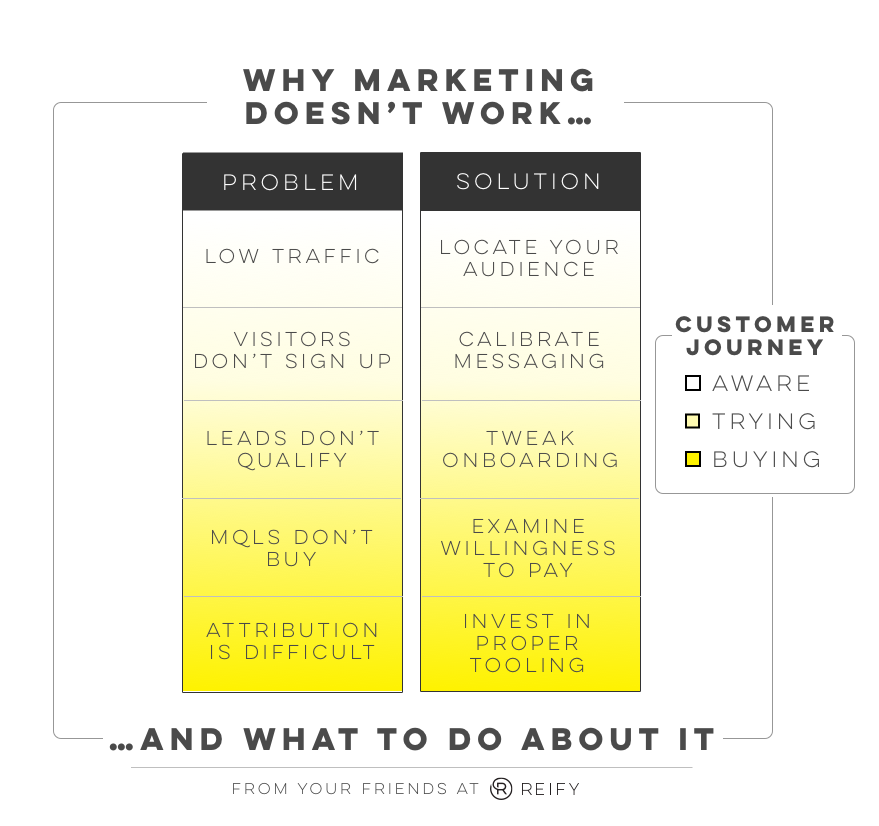Marketing works. We all know it internally, even if we resent it at times. We know it works because we’ve all been successfully marketed to in numerous areas of our lives, both personally and professionally. Unfortunately though, sometimes Marketing doesn’t work, and if you’re the one responsible, it can be overwhelming and very frustrating.
Part of what makes diagnosing issues with Marketing so challenging is that it’s such a big activity. It’s easy to point at this or that number and say “it’s not working!” but it’s harder to take that information and do something about it. Because making abstract things concrete is kind of our thing, we decided to make this easier for everyone by doing one of our favorite things — we made a chart!
 It works until it doesn’t
It works until it doesn’t
For every part of your customer journey, we’ve named a specific problem, and something you can do to help solve it. The next time you’re feeling anxious about marketing, try this: take a step back, look at the chart, pick one area of your customer journey to work on, and start executing!
Locating your audience means doing more than writing blog posts, posting them to HN, and hoping for the best. It means thinking hard about the people you are trying to reach, learning where they congregate, and tailoring your marketing to them directly.
Calibrating your messaging means taking a hard look at what you’re communicating to your potential users, and making the necessary changes to communicate more effectively. Often, software companies settle on messaging early, and even as they tout themselves as agile companies that ship daily, they don’t take the time to tweak their messaging to make up for that delta. This can have serious and negative consequences as time passes.
Tweaking your onboarding is another area that tends to lag behind as products change. Your original onboarding experience likely leaves some things to be desired for new users and new audiences as your product and the market changes. If you’re struggling to gain traction, this is another area that deserves your regular attention — it’s the first chance you have to make a great impression on potential users.
Examining willingness to pay comes from our favorite book about pricing, [Monetizing Innovation](http://monetizinginnovation.com/). One of the central principles of the book is that big mistakes get made when products are brought to market without asking potential customers one simple question — *what are you willing to pay? If you’re curious about this, read the book — it’s worth it.
Finally, investing in proper tooling can be a tough pill for some to swallow, but the dividends can be massive. By proper tooling we mean not building your own analytics pipeline, not hosting your own blog in a static site, etc. — basically, not reinventing the wheel. Invest in some solid marketing automation software, partner with a consultancy that can help you implement, and then start running and never look back.
Of course, this isn’t meant to be an exhaustive list by any means (though we’re thinking of working on a webapp version that has more suggestions — should we?). Instead, it’s designed to jar you back to remembering two things that are very important and all too easy to forget:
-
Worrying won’t solve your problems (if it did, we’d literally have zero problems); and
-
Marketing is an every day practice, not something you do in an erratic frenzy to occasionally assuage your guilt.
We hope this helps! Shoot as an email and let us know what you think.
If your software company needs help translating a helpless feeling of “We’re not doing marketing well enough!” into a sense of ownership and a concrete set of steps to take, get in touch!
